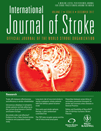Long-term risk of recurrent stroke in young cryptogenic stroke patients with and without patent foramen ovale
Conflict of interest: None declared.
Abstract
Background Among patients with a patent foramen ovale and cryptogenic ischemic stroke, the long-term prognosis is unclear.
Aims This study aims to estimate the recurrence rate in young cryptogenic stroke patients with and without patent foramen ovale.
Patients and methods One hundred eighty-six cryptogenic stroke patients (aged 18–45 years) were prospectively followed for up to five-years. They were divided into two groups according to the echocardiographic presence of patent foramen ovale. All patients received aspirin (100 mg/day) for secondary prevention.
Results Mean age was 32·3 (standard deviation 7·9) years. During the mean follow-up of 66 months five patients with patent foramen ovale had recurrent strokes compared with 11 patients without patent foramen ovale. The average annual rate of recurrent cerebral ischemia was 1·1% and 1·6% for patients with and without patent foramen ovale, respectively. The recurrence rate did not increase with the presence of patent foramen ovale, atrial septal aneurysm or other variables. More than 60% of the reported cases achieved a good functional outcome.
Conclusions Young patients with cryptogenic ischemic stroke with and without patent foramen ovale have a low recurrence rate in a long-term follow-up and most present a favorable outcome. Patent foramen ovale with or without atrial septal aneurysm did not increase the risk of recurrence.




